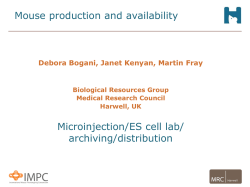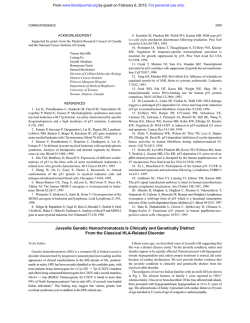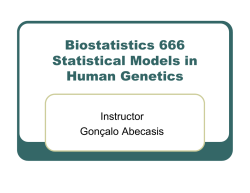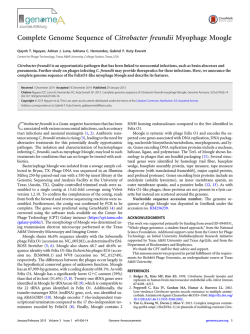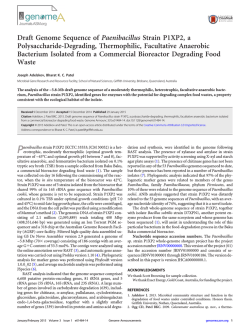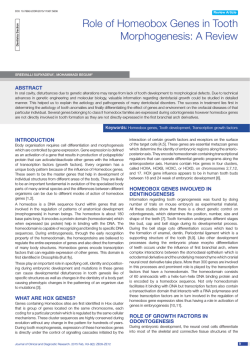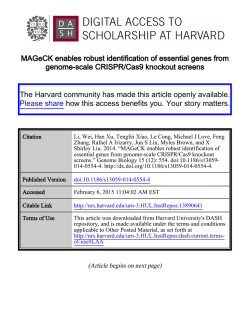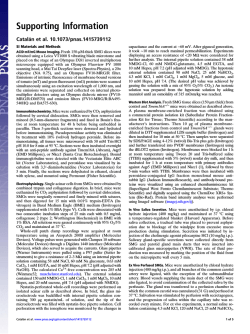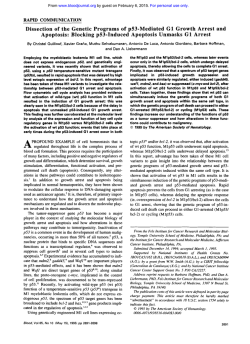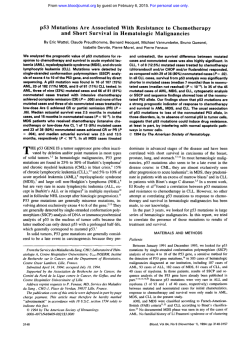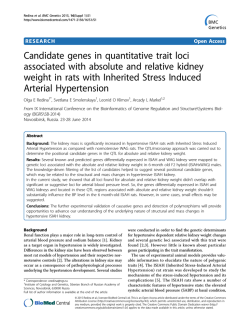
Download Supporting Information (PDF)
Supporting Information Fortier et al. 10.1073/pnas.1418845112 SI Materials and Methods ESC Transfections. ESCs maintained on a feeder layer in 12-well plates were transfected with 2 μg of circular BAC DNA or p53 shRNA lentiviral plasmids (Open Biosystems) using Lipofectamine 2000 Reagent (Invitrogen), according to the manufacturer’s protocol. Selection began after 48 h, with the following concentration of drugs maintained for at least 5 d: 1.5 μg/mL puromycin (Sigma), 150 μg/mL hygromycin (Roche), 15 μg/mL blasticidin (Sigma), or 30 μg/mL zeocin (Invitrogen). Genomic DNA from BAC-transfected clones was isolated using DNAzol (Invitrogen), according to the manufacturer’s instructions. Southern blot detection of transfected BAC DNA was performed using EcoRV digestion and a probe specific to the neomycin gene, as described (1). Total cellular RNA was isolated from BAC-transfected clones (undifferentiated ESCs or EBs) with TRIzol (Invitrogen), according to the manufacturer’s instructions. EB Formation. ESCs were cultured for at least one passage on gelatin-coated dishes before being seeded at a concentration of 1.25 × 103 cells/mL in bacterial-grade 60-mm dishes without LIF [Iscove’s Modified Dulbecco’s Medium; Sigma), 15% heatinactivated FCS (Invitrogen), 5% serum-free and protein-free medium for hybridoma culture (Invitrogen), 2 × 10−3 M L-glutamine (Invitrogen), 50 μg/mL ascorbic acid (Sigma), and 3 × 10−4 M α-monothioglycerol]. EBs were counted at day 8 after LIF removal. For most experiments, EB numbers are expressed as relative values based on primary clone numbers. Ribosome Profiling. Ten minutes before collection, 100 μg/mL cycloheximide was added to the culture medium. Cells were washed in ice-cold PBS supplemented with 100 μg/mL cycloheximide and were collected in polysome lysis buffer [15 mM Tris (pH 7.4), 250 mM NaCl, 15 mM MgCl2, 1% Triton X-100, 100 μg/mL cycloheximide, 1 mM DTT, 400 U/mL RNaseOut (Invitrogen), and protease inhibitors]. Samples were centrifuged at 10,000 × g for 10 min at 4 °C. The resulting supernatant was layered on a 20–50% linear sucrose gradient and centrifuged in a Beckman SW41Ti rotor at 35,000 rpm for 3 h at 4 °C. After centrifugation, the A254 was monitored continuously and recorded using a Gradient Station IP instrument (Biocomp) attached to a UV-MII spectrophotometer (GE Healthcare). 1. Kroon E, et al. (1998) Hoxa9 transforms primary bone marrow cells through specific collaboration with Meis1a but not Pbx1b. EMBO J 17(13):3714–3725. Fortier et al. www.pnas.org/cgi/content/short/1418845112 GO Analysis. Each clone was annotated with a set of GO terms representing the union of the set of GO terms ascribed to all of the genes present in the deleted region of the clone. For each GO term assigned to at least one clone, a two-sided t-test was performed comparing the log EB density (normalized EB numbers) for clones annotated with that GO term against the log EB density for all other clones. GO terms then were ranked based on the significance of their effect on EB formation. The GOrilla application (2) also was used to determine GO enrichments from ranked gene lists. Assessment of p53 Expression Levels. After shRNA selection, gene expression was assessed by qRT-PCR using a Roche Light Cycler 480 with Roche Universal ProbeLibrary (UPL) assays or TaqMan assays (endogenous control genes). For Trp53 (NM_011640) detection, UPL probe no. 25 and the primer pair acgcttctccgaagactgg + agggagctcgaggctgata were used. Reference gene assays (Gapdh and β-actin) were purchased from ABI (20× primer-probe mix, VIClabeled). Protein levels were detected from whole-cell extracts (Laemmli buffer) by Western blotting using p53 (Cell Signaling Technology, catalog no. 2524) and α-tubulin (Cell Signaling Technology, catalog no. 2144) antibodies. BrdU Pulse-Chase Assay. Cells were labeled with BrdU for 15 min and then were collected at various time points before being analyzed for fluorescence by flow cytometry using a BD Canto II cytometer (BD Bioscience) and BD FACSDiva 4.1 software. Annexin V/Propidium Iodide Staining. ESCs or EBs were dissociated and counted before staining with Alexa350-annexin V (Invitrogen Molecular Probes) and propidium iodide (50 μg/mL) in accordance with the manufacturer’s instructions. Fluorescence was evaluated by flow cytometry using a BD Canto II cytometer (BD Bioscience), and data were analyzed with BD FACSDiva 4.1 software. qRT-PCR. Relative quantification of the target genes was calculated as described previously. Primers used for PCR reactions are provided in Table S2. 2. Eden E, Navon R, Steinfeld I, Lipson D, Yakhini Z (2009) GOrilla: A tool for discovery and visualization of enriched GO terms in ranked gene lists. BMC Bioinformatics 10:48. 1 of 11 Fig. S1. Correlation between deletion size and EB numbers. Graphical representation of EB numbers compared with deletion size. The correlation coefficient shows there is no correlation between the two factors. Fig. S2. Increased cell death upon EB formation. (A) BrdU pulse-chase experiments on self-renewing wild-type and Rps14Δ/wt clones. The percentage of BrdUpositive cells is an indication of cell-cycle progression and was assessed 0, 3, 6, 24, and 48 h after the initial BrdU pulse. Error bars show SEM values of two independent experiments. (B) Cell viability experiments. Annexin V and propidium iodide staining was performed on differentiating (EB) wild-type and Rps14Δ/wt clones. Viability was assessed every 3 h for the first 72 h of differentiation. Error bars show SD values of three biological replicates. (C) Total cell counts obtained before cell viability staining for the first 48 h of differentiation. Error bars show SD values of three biological replicates. Fortier et al. www.pnas.org/cgi/content/short/1418845112 2 of 11 Fig. S3. BAC complementation. Complementation experiments using ΔRP-ESCs. Relative EB numbers (based on primary clone values) obtained from mocktransfected (red bars) and BAC-transfected (white bars) clones are represented. Error bars show the SEM of at least two independent experiments. Fortier et al. www.pnas.org/cgi/content/short/1418845112 3 of 11 Fig. S4. p53 status and evaluation of knockdown efficiency. (A) Polysome profiles and p53 expression levels of Rps14Δ/wt and Rps28Δ/wt clones. The reduced 40S peak is indicated by red arrows. Western blot quantifications were made by normalizing p53 levels on α-tubulin with ImageJ software. (B) qRT-PCR assessment of relative p53 expression (RQ) of mock-transfected (Ctl, n = 3) and sh-p53–transfected (n = 10) cells from family 5066. The ΔCt values range from 5.88 (Ctl) to 9.87 (sh-p53 with ∼92% knockdown). (C) Western blot analysis of p53 protein levels in mock- and sh-p53–transfected clones (n = 3 independent transfections) from family 5066. α-Tubulin is used as loading control. IB, immunoblot. (D) Relative EB numbers (expressed as a percentage of primary clone numbers) following BAC or shRNA p53 transfection. Error bars show the SEM of at least two (BAC transfections) or four (shp53 transfections) independent experiments performed in duplicate. Fortier et al. www.pnas.org/cgi/content/short/1418845112 4 of 11 Fig. S5. Polyribosome profiles of undifferentiated ΔRP-ESCs. (A) AUC evaluation. A horizontal line has been drawn from baseline levels, and peaks were delimited manually (dashed lines). For example, the highlighted gray region represents the polysomal AUC to be calculated. The 40S, 60S, 80S, and polysomal regions are labeled 1 to 4, respectively. Quantitation was done using ImageJ image analysis software. (B) Ribosomal profiles of all tested Rp-deleted clones (Rps and Rpl genes) in self-renewal conditions (undifferentiated). Profiles shown are representative of at least two independent experiments. For a full description of the experimental setup, see SI Materials and Methods. Fortier et al. www.pnas.org/cgi/content/short/1418845112 5 of 11 Fig. S6. Differential expression analysis of wild-type vs. Rps5Δ/wt deleted clones. (A) Molecular network, built in String (1), of genes identified from DESeq analysis of EB polysomal fractions. Genes with an adjusted P value (Padj) < 0.1 have been used, and unlinked nodes have been removed. Edges (colored connections) represent predicted functional links, as established by String. (B) DESeq analysis obtained from ESC polysomal fractions. Genes that are differentially expressed (Padj < 0.1) are shown in red. Genes with a Padj < 0.01 are labeled and are enriched for mesodermal differentiation-related genes. 1. Franceschini A, et al. (2013) STRING v9.1: Protein-protein interaction networks, with increased coverage and integration. Nucleic Acids Res 41(Database issue):D808–D815. Fortier et al. www.pnas.org/cgi/content/short/1418845112 6 of 11 Fig. S7. Enrichment graphs of next-generation sequencing experiments. (A) Enrichment curve showing RPKM ratios (wild-type/Rps5Δ/wt EBs) of genes found in total RNA extracts. (B) Enrichment curve showing RPKM ratios (wild-type/Rps5Δ/wt EBs) of genes found in monosomal RNA extracts. (C) Enrichment curve showing RPKM ratios (wild-type/Rps5Δ/wt EBs) of genes found in polysomal RNA extracts. Genes with RPKM ≥1 are shown (n = 12,009 genes). Genes included in the deleted interval are identified on each graph (Zfp128 RPKM <1). The dashed lines represent the theoretical twofold threshold expected for hemizygous Legend continued on following page Fortier et al. www.pnas.org/cgi/content/short/1418845112 7 of 11 deletions. (D) Pearson’s correlation coefficient curve of log2-transformed expression values for RMRP in human cancer samples obtained from the The Cancer Genome Atlas (1) collection and the Institute for Research in Immunology and Cancer Leucégène Project. 1. Cancer Genome Atlas Research Network (2008) Comprehensive genomic characterization defines human glioblastoma genes and core pathways. Nature 455(7216):1061–1068. Fortier et al. www.pnas.org/cgi/content/short/1418845112 8 of 11 Table S1. DelES families used in validation experiments Family ID 9 5001 5002 5006 5007 5008 5010 5016 5017 5023 5026 5029 5030 5032 5034 5035 5045 5048 5056 5066 Validated clone RP gene deleted 9.18 9.37 5001.02 5001.06 5001.18 5001.30 5002.25 5002.31 5002.37 5006.03 5006.13 5006.28 5007.04 5007.06 5007.09 5008.31 5008.20 5008.38 5008.42 5010.14 5010.19 5010.22 5016.22 5016.25 5016.30 5017.04 5017.05 5017.11 5023.12 5023.21 5023.30 5026.09 5026.17 5026.18 5029.01 5029.15 5029.38 5030.07 5030.16 5030.24 5030.28 5032.09 5032.16 5032.23 5034.02 5034.11 5035.01 5035.10 5035.30 5045.10 5045.16 5048.31 5048.34 5056.02 5056.11 5056.33 5066.18 Rps14 Rps14 Rps28, Rpl10a Rps28 Rps28 Rps28 — — — — — — — — — Rps16 — Rps16 Rps16 — — — — — — — — — Rpl12 — Rpl12 — — — — — — — — — Rps3, Rps11, Rps13, Rps16, Rps17, Rps19, Rpl13a, Rpl18, Rps27a — — — Rpl3 Rpl3 — — — — Rps12 Rps18, Rps28, Rpl7l1 Rps18, Rps28 — — — Rps5 Fortier et al. www.pnas.org/cgi/content/short/1418845112 9 of 11 Table S1. Cont. Family ID 5067 5068 5071 5072 5074 5076 5078 5079 5081 5082 5083 5084 5085 5087 5088 Validated clone RP gene deleted 5067.09 5067.30 5067.36 5068.04 5068.05 5068.09 5068.22 5071.15 5071.21 5072.15 5072.19 5074.18 5074.26 5074.31 5076.07 5076.39 5078.03 5078.05 5078.09 5079.26 5079.29 5079.32 5081.06 5081.39 5082.12 5082.29 5082.31 5083.14 5083.26 5084.28 5084.33 5085.15 5085.16 5087.27 5087.42 5087.44 5088.10 5088.14 5088.32 — — — — — — — — Rps9, Rpl28 Rpl22 — Rpl27a Rpl27a Rpl27a Rps19 Rps19 — — — — — — — — — — — — Rpl39l — — — — — — Rpl29 — — — Identification of all clones used in validation experiments are grouped by anchor points (families). The presence of a RP gene deletion is indicated in the last column. Table S2. Primers and probes used for qRT-PCR studies Primers Rmrp_fwd Rmrp_rev Rmrp_HybProbe Rpph1_fwd Rpph1_rev Rpph1_HybProbe Rps5_fwd Rps5_rev Tp53_fwd Tp53_rev Sequence gctctgaaggcctgtttcct cttcttggcgggctaacagt cttatcctttcgcctagggg ggtgagttcccagagagcag cagccattgaactcgcact agcttggaacagactcacgg cactgcgtcgagtgaatcag gctcatctgcaaggcactc acgcttctccgaagactgg agggagctcgaggctgata The table shows the sequences used for qRT-PCR studies. Unless otherwise mentioned, probes from Roche Universal Probe Library were used. Fortier et al. www.pnas.org/cgi/content/short/1418845112 10 of 11 Dataset S1. Analysis of GO-term clustering from the EB-formation screen Dataset S1 The dataset shows the complete GO term clustering analysis file performed on 320 deletion clones with available mapping information. See SI Materials and Methods for complete methodology used for clustering. Dataset S2. List of significant (Padj < 0.1) genes obtained from DESeq analysis Dataset S2 The dataset shows the list of genes that are differentially expressed in wild-type and Rps5Δ/wt clones in the EB polysomal fraction. Only significant (Padj < 0.1) genes are shown. Dataset S3. Analysis of GO-term clustering of polyribosomal fractions Dataset S3 Complete GO term clustering analysis based on processes performed on 12,009 genes (RPKM ≥1) from next-generation sequencing of total, monosomal, and polysomal RNA extracted from sucrose gradient fractions. See SI Materials and Methods for complete methodology used for clustering. Fortier et al. www.pnas.org/cgi/content/short/1418845112 11 of 11
© Copyright 2025
